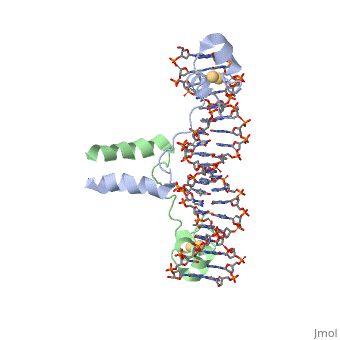Sandbox reserved 1754
From Proteopedia
DNA RECOGNITION BY GAL4: STRUCTURE OF A PROTEIN/DNA COMPLEX
Structural highlights
Function[GAL4_YEAST] This protein is a positive regulator for the gene expression of the galactose-induced genes such as GAL1, GAL2, GAL7, GAL10, and MEL1 which code for the enzymes used to convert galactose to glucose. It recognizes a 17 base pair sequence in (5'-CGGRNNRCYNYNCNCCG-3') the upstream activating sequence (UAS-G) of these genes. Evolutionary ConservationCheck, as determined by ConSurfDB. You may read the explanation of the method and the full data available from ConSurf. Publication Abstract from PubMedA specific DNA complex of the 65-residue, N-terminal fragment of the yeast transcriptional activator, GAL4, has been analysed at 2.7 A resolution by X-ray crystallography. The protein binds as a to a symmetrical 17-base-pair sequence.Each subunit fold into three distinct modules: a compact, (residues 8-40), an (41-49), and an element (50-64). A small, Cd(2+)-containing domain recognizes a conserved CCG triplet at each end of the site through direct contacts with the major groove. The cadmium is coordinated to this domain via interactions with several . A short coiled-coil dimerization element imposes 2-fold symmetry. A segment of extended polypeptide chain links the metal-binding module to the dimerization element and specifies the length of the site. The relatively open structure of the complex would allow another protein to bind coordinately with GAL4. Gal4 also contains an upstream activating sequence () adjacent to that of the promoter region. This sequence works much like an enhancer regions that are common in Eukaryotic genes.The sequence of this UAS appears to be similar to previously determined UAS sequencs, but not quite identical. Some major motifs can be seen in the bases that are interacting with the DNA. Such as, bases 31-35 express a sequence of TCCTC. The protein also appears to not interact with both strands of DNA simultaneously, but rather depends on which half of the dimer is being looked at. DNA recognition by GAL4: structure of a protein-DNA complex.,Marmorstein R, Carey M, Ptashne M, Harrison SC Nature. 1992 Apr 2;356(6368):408-14. PMID:1557122[1] From MEDLINE®/PubMed®, a database of the U.S. National Library of Medicine.
RecA Structure and FunctionText will start here See AlsoReferences
| ||||||||||||||||||


